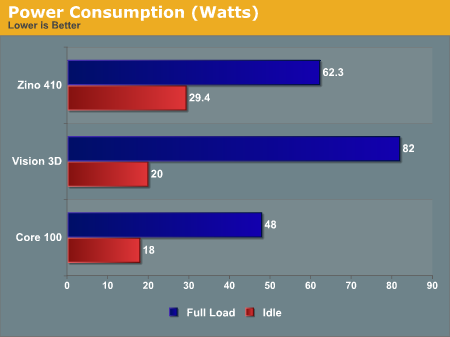Dell Zino HD 410 HTPC Review
by Ganesh T S on February 19, 2011 7:08 AM EST- Posted in
- HTPC
- Dell
- AMD
- Media Streamer
- ATI
HTPC enthusiasts are rightly concerned about the noise factor, heat and power consumption, ease of usage and many other criteria. We will tackle each of these concerns one by one in this section.
Noise
While the Zino 410 is much better than both the ASRock Core 100 and Vision 3D in terms of noise levels, it is not the perfect ultra-quiet HTPC that some enthusiasts crave for. With performance comes the necessity to dissipate generated heat, and the Zino 410's capabilities and form factor mean that it can't be a passively cooled system.
Unfortunately, we don't have the exact noise levels for the Zino 410. However, listening to the Vision 3D, Core 100 and the Zino 410 separately in the same surroundings led me to the conclusion that the Zino 410 was the quietest of the lot.
Power Consumption
In order to get an idea of the power consumption numbers, the Prime95 and Furmark benchmarks were let run overnight to keep both the CPU and GPU completely loaded for an extended duration. Under these extreme conditions, we found the average power consumption to be 62.3 W. At idle, the average power consumption was 29.4 W.

While load power conditions are better than the Vision 3D, it is not as efficient as the Core 100. As for idle power consumption, the system trails both the Core 100 and the Vision 3D.
Ease of Use
HTPC enthusiasts are concerned about how easy it is for their system to come out of standby. Existence of HDMI handshake issues upon return from standby is also a deal breaker for many. Fortunately, the Zino 410 has no issues in these two aspects.
Within Windows, the MCE remote can be made to work with a variety of applications such as XBMC, MediaPortal, MPC-HC and of course, Windows 7 Media Center. Blu Ray players such as PowerDVD and ArcSoft TMT can also be controlled with the help of the MCE remote. The wireless keyboard / mouse combo also supplants the remote for extended functionality.
One of the main drawbacks of pre-built PCs which come with Windows pre-installed is the bloatware. After the review unit finished booting up for the first time, I noticed that there were 67 processes active and 1.13 GB of RAM already utilized. On numerous occasions in course of the review, I was pestered to activate my McAfee subscription and also utilize Dell Backup and other such add-ons. It would have been nice to have some sort of switch to turn off the bloatware completely. Reinstalling the OS is also an option.










69 Comments
View All Comments
silverblue - Saturday, February 19, 2011 - link
...would having two differently-sized SO-DIMMs have on system performance?I'd be tempted to take replace that 4GB module with a 2GB one just to see what happens. 6GB of RAM just doesn't compute. :)
We seem to be getting a decent number of Dell-AMD systems lately... I only hope they take up Brazos with the same level of enthusiasm, because even if it did result in a small drop in performance, this review would've been largely the same in terms of gaming and video playback/quality, albeit with a much smaller footprint. Also, in that scenario, dual channel wouldn't matter as Fusion doesn't support it.
fabarati - Saturday, February 19, 2011 - link
If AMD has anything like Intels asynchronous dual channel, the first 4 GB will perform like dual channel, whilst the remaining 2 GB will perform like single channel.Taft12 - Saturday, February 19, 2011 - link
Dual-channel memory was a scam from the beginning that has somehow survived to this day to make PC buyers think they needed to buy more memory than needed.Have you seen the benchmarks? ~1-2% benefit AT MOST for anything that's not a synthetic memory bandwidth test, regardless of platform.
http://www.tomshardware.com/reviews/PARALLEL-PROCE...
fabarati - Saturday, February 19, 2011 - link
Didn't it help back in the P4 and/or P-M days? And how did it do in early Athlon 64 days?But yeah, Core Duo and newer doesn't really benefit from Dual channel, one
silverblue - Saturday, February 19, 2011 - link
Theoretically, dual channel would help APUs as they're bandwidth-limited.I suppose you're right about standard usage though, even raising memory clocks doesn't make for a sizeable performance advantage.
asmoma - Saturday, February 19, 2011 - link
Starcraft 2 is not a synthetic memory test, and it does benefit from going from 2 to three channels, just read some performance reviews of Starcraft 2.DanNeely - Saturday, February 19, 2011 - link
The einstien@home applications benefitted from a 3rd channel on i7 quad cores; and the 2nd channel on C2 quads as well; high performance server farms/clusters/super computers are a significant segment of the market. On the i7-quad, E@H had a 66% speedup from the 2nd channel, and a 5% gain from the 3rd. Sandybridge gave a similar speedup from the 2nd channel. I can't find the thread with the C2Quad results, but IIRC they were a 10-25% speedup.http://einstein.phys.uwm.edu/forum_thread.php?id=8...
I don't have benchmarks handy, but I suspect a heavily loaded DB server would also benefit from the extra memory bandwidth because the queries would result in a psudorandom memory access pattern that would limit the ability of the cache controller to prefetch most of the data being requested.
jeremyshaw - Friday, March 4, 2011 - link
that actually had to do with uncore clocks, not memory channels.vailr - Saturday, February 19, 2011 - link
How would a Mac Mini compare?Could a Mac Mini be retrofitted with a Blu-Ray drive (since Blu-Ray is available factory installed) and then run as a Windows HTPC?
tipoo - Saturday, February 19, 2011 - link
Why on earth would you buy a Mini to run as a Windows HTPC? You'd pay more for less performance.